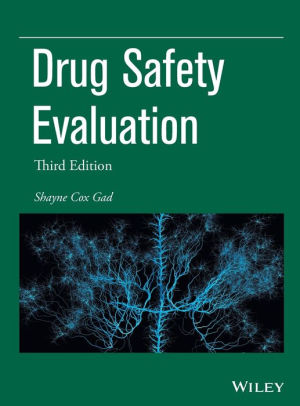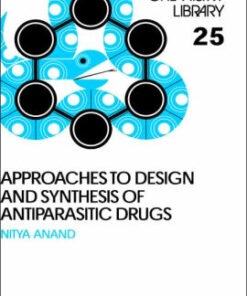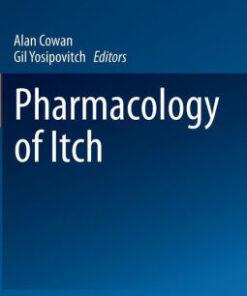(PDF) Drug Safety Evaluation 3rd Edition by Shayne Cox Gad
$28.00
Download instantly Drug Safety Evaluation 3rd Edition by Shayne Cox Gad. It is ebook in PDF format.
ISBN-10: 1119097398 ISBN-13: 9781119097396
Preview
This is the PDF eBook version for Drug Safety Evaluation 3rd Edition by Shayne Cox Gad
Table of Contents
PREFACE xxv
ABOUT THE AUTHOR xxvii
1 The Drug Development Process and the Global Pharmaceutical Marketplace 1
1.1 Introduction 1
1.2 The Marketplace 1
1.3 History of Modern Therapeutics 4
1.4 The Drug Development Process 6
1.5 Strategies for Development: Large Versus Small Company or the Short Versus Long Game 7
1.6 Safety Assessment and the Evolution of Drug Safety 11
1.7 The Three Stages of Drug Safety Evaluation in the General Case 11
References 12
2 Regulation of Human Pharmaceutical Safety: Routes to Human Use and Market 13
2.1 Introduction 13
2.2 Brief History of US Pharmaceutical Law 13
2.3 FDAMA Summary: Consequences and Other Regulations 19
2.4 Overview of US Regulations 21
2.5 Organizations Regulating Drug and Device Safety in the United States 24
2.6 Process of Pharmaceutical Product Development and Approval 25
2.8 Toxicity/Safety Testing: Cellular and Gene Therapy Products 33
2.9 Toxicity Testing: Special Cases 35
2.10 International Pharmaceutical Regulation and Registration 41
2.11 Combination Products 50
2.12 Conclusions 55
References 55
Further Reading 57
3 Data Mining: Sources of Information for Consideration in Study and Program Design and in Safety Evaluation 59
3.1 Introduction 59
3.2 PC-Based Information Products: Laser DISC 65
3.3 Conclusions 65
References 65
4 Screens in Safety and Hazard Assessment 67
4.1 Introduction 67
4.2 Characteristics of Screens 68
4.3 Uses of Screens 70
4.4 Types of Screens 71
4.5 Criterion: Development and Use 71
4.6 Analysis of Screening Data 73
4.7 Univariate Data 73
References 76
5 Formulations, Routes, and Dosage Regimens 79
5.1 Mechanisms 81
5.2 Common Routes 83
5.3 Formulation of Test Materials 96
5.4 Dosing Calculations 105
5.5 Calculating Material Requirements 105
5.6 Excipients 106
References 111
6 Nonclinical Manifestations, Mechanisms, and End Points of Drug Toxicity 115
6.1 Manifestations 115
6.2 Mechanisms of Toxicity 116
6.3 End Points Measured in General Toxicity Studies 116
6.4 Complications 126
References 126
7 Pilot Toxicity Testing in Drug Safety Evaluation: MTD and DRF 129
7.1 Introduction 129
7.2 Range-Finding Studies 130
7.3 Acute Systemic Toxicity Characterization 138
7.4 Screens 150
7.5 PILOT and DRF Studies 154
References 156
8 Repeat-Dose Toxicity Studies 159
8.1 Objectives 159
8.2 Regulatory Considerations 161
8.3 Study Design and Conduct 162
8.4 Study Interpretation and Reporting 165
References 166
9 Genotoxicity 169
9.1 ICH Test Profile 169
9.2 DNA Structure 169
9.3 Cytogenetics 176
9.4 In Vitro Cytogenetic Assays 193
9.5 In Vivo Cytogenetic Assays 196
9.6 Sister Chromatid Exchange Assays 197
References 199
10 QSAR Tools for Drug Safety 209
10.1 Structure–Activity Relationships 209
10.2 SAR Modeling Methods 210
10.3 Applications in Toxicology 212
10.4 Genotoxicity 215
10.5 Comparison of Available Models/Applications 216
References 222
11 Immunotoxicology in Drug Development 225
11.1 Introduction 225
11.2 Overview of the Immune System 227
11.3 Immunotoxic Effects 229
11.4 Immunosuppression 231
11.5 Immunostimulation 235
11.6 Regulatory Positions 240
11.7 Evaluation of the Immune System 245
11.8 Nonspecific Immunity Function Assay 251
11.9 T-Cell-Dependent Antibody Response (TDAR) 253
11.10 Approaches to Compound Evaluation 259
11.11 Problems and Future Directions 263
References 264
12 Nonrodent Animal Studies 269
12.1 Introduction 269
12.2 Comparison Between Rodent and Nonrodent Experimental Design 269
12.3 Differences in Study Activities 270
12.4 Nonrodent Models 270
12.5 Dog 270
12.6 The Ferret 273
12.7 The Pig 275
12.8 Nonhuman Primates 279
12.9 Statistics in Large Animal Studies 283
12.10 Summary 288
References 288
13 Developmental and Reproductive Toxicity Testing 291
13.1 Introduction 291
13.2 ICH Study Designs 293
13.3 Methodological Issues 298
13.4 Developmental Studies in Primates 303
13.5 Data Interpretation 304
13.6 Juvenile and Pediatric Toxicology 310
13.7 In Vitro Tests for Developmental Toxicity 312
13.8 Appraisal of Current Approaches for Determining Developmental and Reproductive Hazards 316
References 317
14 Carcinogenicity Studies 321
14.1 Introduction 321
14.2 Mechanisms and Classes of Carcinogens 322
14.3 Genotoxic Carcinogens 322
14.4 Epigenetic Carcinogens 325
14.5 Regulatory Requirements and Timing 328
14.6 Species and Strain 328
14.7 Animal Husbandry 330
14.8 Dose Selection 330
14.9 Group Size 331
14.10 Route of Administration 332
14.11 Study Duration 332
14.12 Survival 332
14.13 End Points Measured 333
14.14 Transgenic Mouse Models 335
14.15 Interpretation of Results: Criteria for a Positive Result 338
14.16 Statistical Analysis 338
14.17 Weight-of-Evidence Factors for Consideration in a Carcinogenicity Assessment Document (CAD) 344
14.18 Conclusions 345
References 345
15 Histopathology in Nonclinical Pharmaceutical Safety Assessment 351
15.1 Introduction 351
15.2 Clinical Pathology 355
References 356
16 Irritation and Local Tissue Tolerance in Pharmaceutical Safety Assessment 359
16.1 Introduction 359
16.2 Factors Affecting Irritation Responses and Test Outcome 359
16.3 Primary Dermal Irritation (PDI) Test 360
16.4 Other Nonparenteral Route Irritation Tests 362
16.5 Ocular Irritation Testing 362
16.6 Vaginal Irritation 364
16.7 Acute Primary Vaginal Irritation Study in the Female Rabbit 365
16.8 Parenteral Irritation/Tolerance 367
16.9 Problems in Testing (and Their Resolutions) 370
16.10 Phototoxicity 371
16.11 Hemocompatibility 377
References 378
17 Pharmacokinetics and Toxicokinetics in Drug Safety Evaluation 381
17.1 Introduction 381
17.2 Regulations 382
17.3 Principles 382
17.4 Pharmacokinetics 395
17.5 Laboratory Methods 395
17.6 Sampling Methods and Intervals 397
17.7 Study Types 400
17.8 Analysis of Data 402
17.9 Physiologically Based Pharmacokinetic (PBPK) Modeling 404
17.10 Points to Consider 405
17.11 Biologically Derived Materials 406
17.12 Points to Consider 410
References 410
18 Safety Pharmacology 413
18.1 Regulatory Requirements 414
18.2 Study Designs and Principles 415
18.3 Organ System-Specific Tests 416
18.4 Cardiovascular 416
18.5 Central Nervous System 419
18.6 Respiratory/Pulmonary System 422
18.7 Secondary Organ System 427
18.8 Renal Function Tests 428
18.9 Summary 428
References 428
19 Special Concerns for the Preclinical Evaluation of Biotechnology Products 433
19.1 Regulation 436
19.2 Preclinical Safety Assessment 437
19.3 Recombinant DNA Technology 439
19.4 Immunogenicity/Allergenicity 440
19.5 Monoclonal Antibody Technology 441
19.6 Bioprocess Technology 446
19.7 Gene Therapy Products 446
19.8 Vaccines 449
19.9 Special Challenges 452
19.10 Planning a Safety Evaluation Program 454
19.11 Challenges: Biosimilars 458
References 459
20 Safety Assessment of Inhalant Drugs and Dermal Route Drugs 461
20.1 Inhaled Therapeutics 461
20.2 The Pulmonary System 461
20.3 Penetration and Absorption of Inhaled Gases and Vapors 462
20.4 Deposition of Inhaled Aerosols 463
20.5 Absorption and Clearance of Inhaled Aerosols 464
20.6 Pharmacokinetics and Pharmacodynamics of Inhaled Aerosols 464
20.7 Methods for Safety Assessment of Inhaled Therapeutics 465
20.8 Parameters of Toxicity Evaluation 467
20.9 Inhalation Exposure Techniques 470
20.10 The Utility of Toxicity Data 473
20.11 Formulation and Potential Mucosal Damage 473
20.12 Therapeutic Drug Delivery by the Dermal Route 474
References 476
21 Special Case Products: Imaging Agents 483
21.1 Introduction 483
21.2 Imaging Agents 483
References 487
22 Special Case Products: Drugs for Treatment of Cancer 489
22.1 Introduction 489
References 493
23 Pediatric Product Safety Assessment (2006 Guidance, Including Juvenile Toxicology) 495
23.1 Introduction 495
23.2 Issues to Consider Regarding Juvenile Animal Studies 498
23.3 General Considerations in Designing Toxicity Studies in Juvenile Animals 499
23.4 Study Designs and Considerations 500
References 501
24 Use of Imaging, Imaging Agents, and Radiopharmaceuticals in Nonclinical Toxicology 503
24.1 Introduction 503
24.2 X-ray 505
24.3 Positron Emission Tomography (PET) 505
24.4 Single-photon Emission Computed Tomography (SPECT) 505
24.5 Computed Tomography (CT) 506
24.6 Magnetic Resonance Imaging (MRI) 506
24.7 Optical Imaging 507
24.8 Ultrasound 508
24.9 Nanoparticle Contrast Agents 509
24.10 Radiopharmaceuticals 509
24.11 Applications of Preclinical Imaging in Laboratory Animals 509
24.12 Nonclinical Safety Assessment for Imaging Agents 515
24.13 Radiopharmaceuticals 517
24.14 Nonclinical Late Radiation Toxicity Studies 519
24.15 Study Design 519
References 520
25 Occupational Toxicology in the Pharmaceutical Industry 523
25.1 Introduction 523
25.2 Occupational Toxicology versus Drug Safety Evaluation 523
25.3 Regulatory Pressures in the United States and the European Community 525
25.4 Organizational Structure 526
25.5 Activities 527
25.6 Conclusion 534
References 534
26 Strategy and Phasing for Nonclinical Drug Safety Evaluation in the Discovery and Development of Pharmaceuticals 537
26.1 Introduction 537
26.2 Regulatory Requirements 539
26.3 Essential Elements of Project Management 542
26.4 Screens: Their Use and Interpretation in Safety Assessment 544
26.5 Strategy and Phasing 546
26.6 Critical Considerations 550
26.7 Special Cases in Safety Assessment 551
26.8 Summary 551
References 551
27 The Application of In Vitro Techniques in Drug Safety Assessment 553
27.1 Introduction 553
27.2 In Vitro Testing in Pharmaceutical Safety Assessment 555
27.3 Defining Testing Objective 558
27.4 Test Systems: Characteristics, Development, and Selection 558
27.5 In Vitro Models 559
27.6 Lethality 560
27.7 In Silico Methods 572
27.8 The Final Frontier and Barrier: Regulatory Acceptance 573
27.9 Summary 573
References 575
Further Reading 581
28 Evaluation of Human Tolerance and Safety in Clinical Trials: Phase I and Beyond 583
28.1 The Pharmaceutical Clinical Development Process and Safety 583
28.1.1 Pharmacokinetics 589
28.1.2 Safety of Clinical Trial Subjects 591
28.2 Limitations on/of Clinical Trials 598
28.3 The Clinical Trial Process 598
28.4 Institutional Review Boards (IRBS)/Ethics Committees in the Clinical Trial Process 602
28.5 Drug Formulations and Excipients 604
28.6 Phase I Designs 605
28.7 Clinical Trial Safety Indicators 609
28.8 Assessment of Unwanted Drug Effects 621
References 626
29 Postmarketing Safety Evaluation : Monitoring, Assessing, and Reporting of Adverse Drug Responses (ADRs) 629
29.1 Causes of Safety Withdrawals 637
29.2 Regulatory Requirements 638
29.3 Management of ADR and ADE Data 641
29.4 Causality Assessment 647
29.5 Courses of Corrective Action 647
29.6 Legal Consequences of Safety Withdrawal 648
References 651
30 Statistics in Pharmaceutical Safety Assessment 653
30.1 Introduction 653
30.2 Experimental Design 659
30.3 Data Recording 664
30.4 Generalized Methodology Selection 665
30.5 Statistical Analysis: General Considerations 665
30.6 Hypothesis Testing of Categorical and Ranked Data 679
30.7 Hypothesis Testing: Univariate Parametric Tests 684
30.8 Methods for the Reduction of Dimensionality 694
30.9 Meta-Analysis 701
30.10 Bayesian Inference 702
30.11 Data Analysis Applications in Safety Assessment Studies 704
References 708
31 Combination Products: Drugs and Devices 711
31.1 Combination Products 711
References 720
32 Qualification of Impurities, Degradants, Residual Solvents, Metals, and Leachables in Pharmaceuticals 721
32.1 Impurities 721
32.2 Residual Solvents 726
32.3 Extractables and Leachables 727
32.4 Residual Metals and Elements 728
References 730
33 Tissue, Cell, and Gene Therapy 731
33.1 Safety Assessment of Cell Therapy (CT) Products 732
33.2 Nonclinical Safety Assessment of Gene Therapy Products (GTPS) 738
33.3 Definitions 741
References 742
Appendix A: Selected Regulatory and Toxicological Acronyms 743
Appendix B: Definition of Terms and Lexicon of “Clinical” Observations in Nonclinical (Animal) Studies 745
Appendix C: Notable Regulatory Internet Addresses 749
Appendix D: Glossary of Terms Used in the Clinical Evaluation of Therapeutic Agents 755
Appendix E: Common Vehicles for the Nonclinical Evaluation of Therapeutic Agents 759
Appendix F: Global Directory of Contract Pharmaceutical Toxicology Labs 857
INDEX 879




